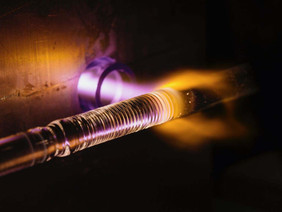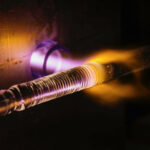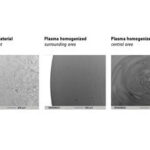- Home
- Research
- Fiber Research and Technology
- Research results
- Homogenization of Doped Fused Silica via Plasma-based Processes
Homogenization of Doped Fused Silica via Plasma-based Processes

23.04.2018
In order to improve the homogeneous concentration distribution of different dopants in the fused silica matrix, especially in the REPUSIL process, a plasma-based thermal post-treatment step was developed and optimized. The combination of the highly selective heating zone of a plasma burner with the mechanical torsion of the material results in a very efficient homogenization of doped fused silica.
By: Volker Reichel // Hardy Baierl // Tom Trautvetter // Kay Schuster
Various plasma-assisted processes have been developed and tested for a more homogeneous radial distribution of the dopant concentration with the aim of achieving a homogeneous refractive index in bulk optical glasses and at the core of passive and active optical fibers. Particularly in powder-based manufacturing processes, such as the REPUSIL process, additional thermal and mechanical post-treatment is required to achieve this goal.
The technological basis of the developed process is a device with two rotating three-jaw chucks into which the so-called preform (doped fused silica rod) is clamped after its completion. The rotating speed of the chucks can be controlled separately. A plasma burner with a very narrow heating zone fixed on a linear stage is moved along the rotating preform. This highly selective energy input ensures structural stability and simultaneous local homogenization.
By varying the gas composition in the plasma flame and the torsion rate, it was possible to optimize the crucial process parameters (temperature, absolute value, and difference in rotational speeds) in such a way that significantly more homogeneous dopant distributions were achieved. The influence of this method on the homogeneity of the concentration of the passive and laser-active dopants introduced during the preparation process is demonstrated on sample slices of about 1 mm of thickness (polished on both sides), firstly via scanning electron microscopy and secondly via electron probe micro analysis (EPMA). Figure 1 shows the setup with a preform during the homogenization process.
Figure 2 compares light microscopic images before and after homogenization.
The patent-pending homogenization process is used in the manufacturing of special optical preforms for laser-active optical fibers or bulk optical components for use in high-performance fiber lasers and pulsed high-energy laser systems.
Funded by: BMBF, Leibniz Association
RELATED PUBLICATIONS
EP application number 16176590.4-1375


